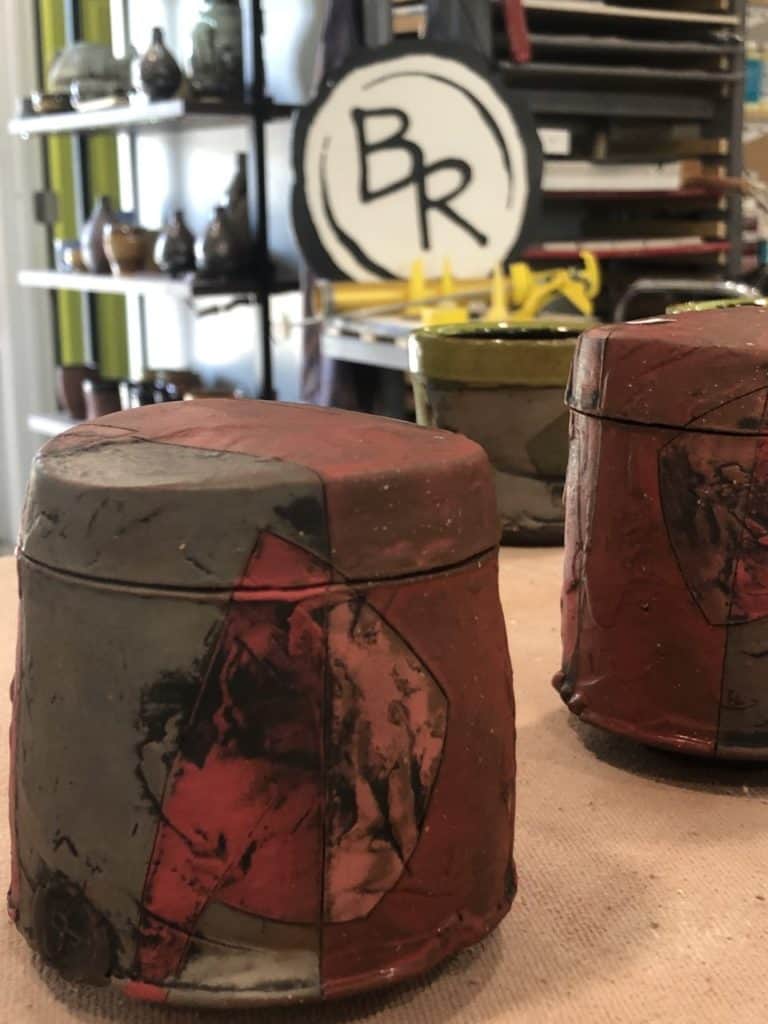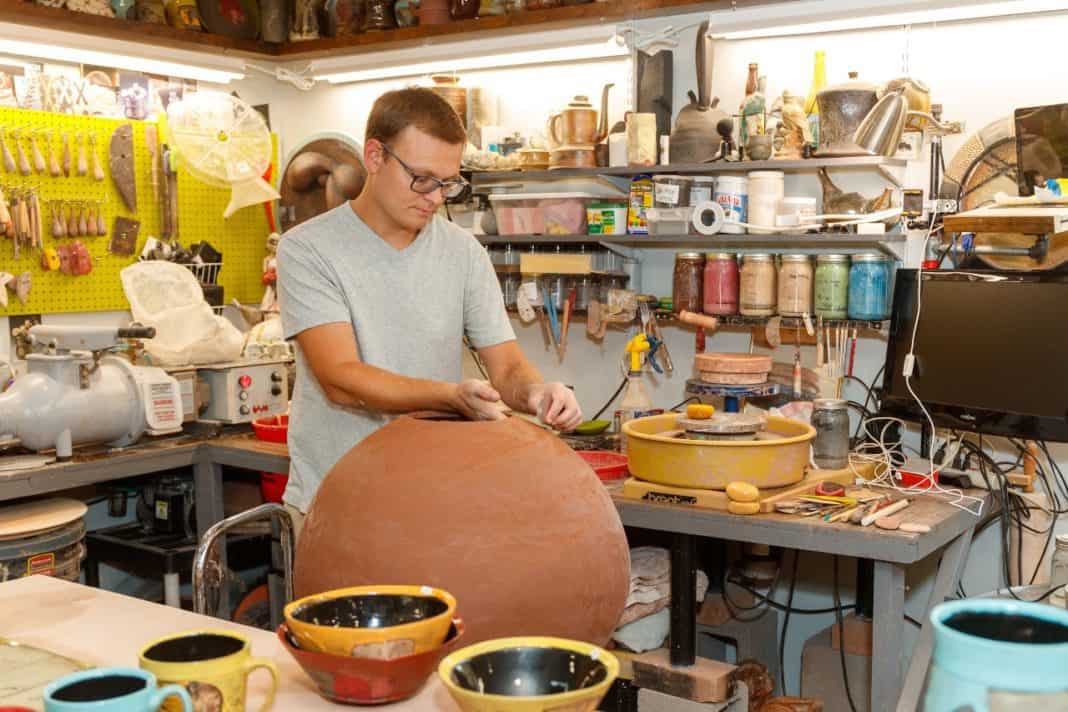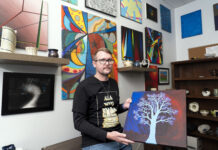Steve Jobs once said, “You can’t connect the dots looking forward; you can only connect them looking backwards. So you have to trust that the dots will somehow connect in your future.” The idea behind this concept is that we cannot predict our future, however, if we look at our past, we can see how life’s twists and turns got us to where we are at this very moment.
For Ben Roti, life has an interesting way of connecting the dots. Roti is a ceramic artist who lives and works in Camp Verde. Throughout his life, he had a series of connections that led him to work with one of the most prolific ceramic artists of the 20th and 21st centuries.
Roti began his ceramics career in the sixth grade when his parents were trying to find something that he would enjoy doing after school. He was not particularly interested in sports, so they took him to the Lakes Art Center in Spirit Lake, Iowa, where he began taking pottery classes.
“There were some elderly women throwing on the pottery wheels and I guess I must of looked like I wanted to throw, so one of them invited me to come over and sit. Basically, I repeated the steps that she was doing as she explained it to me,” Roti said.
That was just the beginning. It wasn’t until his first actual class in high school that he began to fall in love with ceramics. Along the way, each of his teachers played a significant role in his life, encouraging him to think out of the box as he created his art, while others suggested that he continue his education in ceramics. While in college, Roti met Mat Rude, an instructor at the University of Iowa. Rude had spent a good part of his career working with distinguished ceramic artists, one of them being Don Reitz.
Reitz Ranch Center
Along the Verde River in Sycamore Canyon, Reitz, a world-renowned ceramic artist, set up shop. He built a place where artists from all disciplines could visit and use the property to further their creative energy. Don Reitz believed that making pots was a way of life. It was about the way you think; about the way your mind is; it’s about what has affected you all your life, he said. His own work pushed the boundaries of working with clay and experimentation. He pioneered a style that radically changed the course of modern ceramic art.
Reitz invited other renowned collaborators in the ceramic art world to the ranch. There, they would fire the anagama kilns and made a big to do about it.
“My art has always come out of need. Not everyone may like what I do, but I can only make what I feel in my heart. You have to have courage to put out what you know to be truth,” Reitz said.
On March 19, 2014, Reitz passed away, leaving behind a legacy.
“I feel that it is important to share that history with the newer generations who are up and coming. Don is that lost legacy that is no longer around to share that part of history and there are a few people splattered across the country that were his assistants. We all have this pretty unique tie for spending that time together, but feel enriched in a way that we are able to share a lot of those stories with people and share the amazing individual that Don was and is. I still feel like he is around, with us,” Roti said.
In 2017, Sheryl and Ted Davault purchased Reitz Ranch and moved from their home in Phoenix. The couple has turned the ranch into a Center for Ceramic Arts, where members have free run of the ranch’s studio, as well as working on the same kilns and wheels that Reitz used.
Reitz’s Protégé
Upon graduating from the University of Iowa, Roti moved to Tucson, where he was trying to figure out his next steps. He received a call from Mat Rude, his professor in college, asking if he would be interested in working with Reitz. Rude had been Reitz’s assistant and understood how to work with him. He felt that Roti was a great candidate. Roti jumped at the chance.
“I questioned it a lot when I first got out there [Reitz Ranch], that this couldn’t be me. I would tell people that I would go to these conferences and I would go to his [Reitz’s] workshops — I even traveled across the country and went to Florida to be his assistant in a workshop for a month. I just came from Iowa three months before and never thought that this is what my life would be like. … I would be in the studio one-on-one with Don, sitting right across the wheel from him ready to hand him the next tool. We got into a rhythm of where I knew how he worked and there was this unspoken language of just being his assistant in the studio. He would finish using a tool and I would clean it and have it ready as soon as he needed it right back. I would sit there and pinch myself to make sure that I wasn’t dreaming. It just seemed crazy that this is someone I studied in school, learned a lot about and didn’t fully understand or grasp his kind of worldliness of how big he really was. But reflecting now on this, none of that mattered to him — none of the fame. He really enjoyed conversation. I guess it was just a lot of luck on that timeline,” Roti said.
Reitz was an inspiration to Roti as he mentored him. As closely as he worked with Reitz, he never felt for one moment that he was in his shadow.
“It was difficult in feeling the energy enough, after working a full day with Don, to then go and work on my own stuff. It was mentally and physically draining to make a bunch of clay to firing kilns and then finding the time and energy to go into the studio to do some of your own work. But he [Don] was really good at reminding you that if you weren’t in the studio for a few days, he would come down and check things out. He never influenced the work in telling me what to do in my own work. He did in his own work because it was his, but when it came to my own work he was really good about encouraging and pushing me. He saw strengths in the things that I didn’t see myself and he was amazing at that. I miss that. I worked as much as I could at the time. Looking back, I wished that I could have done more because I had that connection with Don. I was honored to be in the shadow of Don Reitz. There are very few people that had that privilege to be a studio assistant, and I felt that it gave me a leg up in the clay world,” Roti said. “Don worked on a very large scale and he opened my eyes to be able to combine elements in clay and combine multiple pieces together to start to work in a scale that you have to interact with,” Roti said.
After Reitz passed, Roti said that he felt lost and floundered a little while trying to figure out what was his purpose.
“Don worked six to seven days a week — everyday there was something that he wanted to do. I gained the most appreciation of how incredibly prolific he was.”
One of the greatest lessons that he learned from Don Reitz was his three quarter theory. It was based on the idea that when a piece is three-quarters of the way through, you should start thinking about the next piece and how you are going to make that one better.
“I have been working to find my own voice, but as I move further away from his teachings, I feel that I have grown as an artist. I can imagine that he is looking down saying that is exactly what he would want.”
The Soul of Art
As Roti works on his next piece, he marks the clay with lines, scratches, images and even fingerprints to his work. His signature statement is filled with meaning as well as a “tip of his hat” paying homage to a man that influenced his career.

“I try to put my emotion or marks in a piece in a way that can be visually read. The things that I put on my work I feel is a part of me — it is a representation of me, my art and myself,” he said. Roti believes that an artist’s soul will always be a part of their own work.
“I find that the soul of an object, a ceramic object, is when people are drawn to it for whatever reason. Whether it is visual, or they can foresee some function out of it, or just they admire looking at it. That to me is that soul of that object emanating out of the piece itself.”
As Roti begins to connect the dots and reflect on his past, he says, “without Mat, I would have never met Don. And if I didn’t transfer to Iowa, I would have never met Mat. There are all these things that make it hard to believe how that timeline went. But when I look back, I guess the biggest thing that one of my original high school instructors always said, ‘is to say yes — keep putting yourself out there, keep going.’ That has been my motto — all these things have led to other things.






















